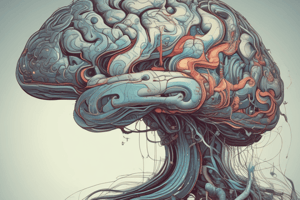Podcast
Questions and Answers
The __ side of the brain processes information in a linear manner. It processes from part to whole. It takes pieces, lines them up, and arranges them in a logical order.
The __ side of the brain processes information in a linear manner. It processes from part to whole. It takes pieces, lines them up, and arranges them in a logical order.
Left
The ___ side of the brain processes from whole to parts, holistically. It starts with the answer. It sees the big picture first, not the details.
The ___ side of the brain processes from whole to parts, holistically. It starts with the answer. It sees the big picture first, not the details.
Right
If you are ___-brained, you may have difficulty following a lecture unless you are given the big picture first.
If you are ___-brained, you may have difficulty following a lecture unless you are given the big picture first.
Right
In addition to thinking in a linear manner, the __ brain processes in sequence
In addition to thinking in a linear manner, the __ brain processes in sequence
This side of the brain uses random, fantasy oriented processing.
This side of the brain uses random, fantasy oriented processing.
This is a type of memory disruption that leads to inaccurate, distorted or fabricated memories where information is made up.
This is a type of memory disruption that leads to inaccurate, distorted or fabricated memories where information is made up.
What is the term for the denial of deficits?
What is the term for the denial of deficits?
What is prosopagnosia?
What is prosopagnosia?
This is the term used when individuals get stuck or repeat the same information. Iti is an inability to switch ideas or responses.
This is the term used when individuals get stuck or repeat the same information. Iti is an inability to switch ideas or responses.
What is the #1 reported change in RHD patients?
What is the #1 reported change in RHD patients?
Describe communication impairments that RHD patients display.
Describe communication impairments that RHD patients display.
Anosognosia is a perceptual impairment characterized by the denial of deficits. It can manifest in varying ways in individuals. Please describe some of these variations/characteristics.
Anosognosia is a perceptual impairment characterized by the denial of deficits. It can manifest in varying ways in individuals. Please describe some of these variations/characteristics.
What causes prosopagnosia, or the inability to recognize faces?
What causes prosopagnosia, or the inability to recognize faces?
Patients with RHD may suffer from this impairment, characterized by the inability to draw, copy and/or create geometric designs, and reproduce two or three dimensional figures. They often leave out left-sided details and/or add extraneous details.
Patients with RHD may suffer from this impairment, characterized by the inability to draw, copy and/or create geometric designs, and reproduce two or three dimensional figures. They often leave out left-sided details and/or add extraneous details.
What is left hemispatial neglect?
What is left hemispatial neglect?
Provide 3 examples of errors patients with left neglect may make.
Provide 3 examples of errors patients with left neglect may make.
Damage to these parts of the brain causes left hemispatial neglect.
Damage to these parts of the brain causes left hemispatial neglect.
Name 1 technique to help patients with left neglect when reading.
Name 1 technique to help patients with left neglect when reading.
If you have important information to share with a patient with RHD/left neglect, what side should you stand on when speaking to him or her?
If you have important information to share with a patient with RHD/left neglect, what side should you stand on when speaking to him or her?
What is the main difference between hemianopia and neglect?
What is the main difference between hemianopia and neglect?
Describe 3 characteristics of impaired communication.
Describe 3 characteristics of impaired communication.
Communication typically contains more content and fewer words.
Communication typically contains more content and fewer words.
Syntax, grammar, phonological processing, and word retrieval typically are not affected in patients with right hemisphere dysfunction.
Syntax, grammar, phonological processing, and word retrieval typically are not affected in patients with right hemisphere dysfunction.
Describe 3 pragmatic impairments individuals with RHD might exhibit.
Describe 3 pragmatic impairments individuals with RHD might exhibit.
The right hemisphere plays an important role in the recognition and expression of emotion. Individuals with RHD typically have impaired/inappropriate expressions of personal emotions and difficulty appreciating other people’s emotions. How else can emotion be impaired?
The right hemisphere plays an important role in the recognition and expression of emotion. Individuals with RHD typically have impaired/inappropriate expressions of personal emotions and difficulty appreciating other people’s emotions. How else can emotion be impaired?
Briefly describe theory of mind.
Briefly describe theory of mind.
What are the 3 approaches to treatment? Please describe.
What are the 3 approaches to treatment? Please describe.
Patients with RHD may exhibit indifference and denial, are likely to be passive in therapy, and may neglect homework. How can SLPs manage these behaviors in treatment?
Patients with RHD may exhibit indifference and denial, are likely to be passive in therapy, and may neglect homework. How can SLPs manage these behaviors in treatment?
Name 3 tasks to improve attention and distractibility.
Name 3 tasks to improve attention and distractibility.
Please describe how you can treat impulsivity.
Please describe how you can treat impulsivity.
In general, there is little research on treatment for cognitive-communication disorders that are associated with RHD, except for ___?
In general, there is little research on treatment for cognitive-communication disorders that are associated with RHD, except for ___?
Flashcards are hidden until you start studying


